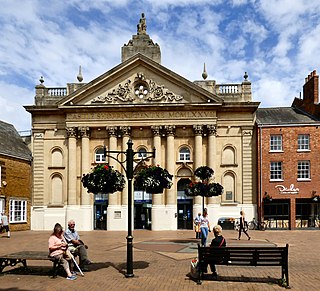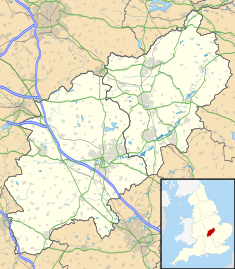
The Corn Exchange is a commercial building on The Payment in St Ives, Cambridgeshire, England. The structure, which is currently used as an events venue, is a Grade II listed building.

Corn exchanges are distinct buildings which were originally created as a venue for corn merchants to meet and arrange pricing with farmers for the sale of wheat, barley, and other corn crops. The word "corn" in British English denotes all cereal grains, such as wheat and barley. With the repeal of the Corn Laws in 1846, a large number of corn exchanges were built in England, particularly in the corn-growing areas of Eastern England.

The Corn Exchange is a trading space and events venue in Doncaster, South Yorkshire, England. The structure, which was commissioned as a corn exchange, is part of a Grade II* listed complex.

The Municipal Offices is a municipal building in Bowling Green Road in Kettering, Northamptonshire, England. The building accommodates the offices and meeting place of Kettering Town Council.

The Corn Exchange is a commercial building in Tuesday Market Place, King's Lynn, Norfolk, England. The structure, which was commissioned as a corn exchange and is now used as an events venue, is a Grade II listed building.

The Cornhill Corn Exchange was a commercial building in the Market Place, Banbury, Oxfordshire, England. The façade of the building, which has been preserved and now forms an entrance to a shopping centre, is a Grade II listed building.

The Corn Exchange is a commercial building in Gloucester Street in Faringdon, Oxfordshire, England. The structure, which is currently used as a community events venue, is a Grade II listed building.

The Corn Exchange is a commercial building in Drury Lane in Liverpool, Merseyside, England. The structure has been converted into apartments and studios.

The Corn Exchange is a commercial building in Queen Street, Market Rasen, Lincolnshire, England. The structure, which is used as the offices of a firm of charted surveyors, is a Grade II listed building.

The Corn Exchange is a commercial building in Market Street, Witney, Oxfordshire, England. The structure, which is used as a public events venue, is a Grade II listed building.

The Corn Exchange is a commercial building in the Market Place, Wallingford, Oxfordshire, England. The structure, which is used as a theatre, is a Grade II listed building.

The Corn Exchange is a commercial building in the Market Place, Fakenham, Norfolk, England. The structure, which is currently used as a cinema, is a Grade II listed building.

The Corn Exchange is a commercial building in the Corn Market, Romsey, Hampshire, England. The structure, which is has been used extensively as a bank branch, is a Grade II* listed building.

The Corn Hall is a commercial building in the Market Place, Cirencester, Gloucestershire, England. The structure, which is used as a shopping arcade and community events venue, is a Grade II listed building.

The Corn Hall is a commercial building in the Market Place, Swaffham, Norfolk, England. The structure, which is used as offices and as a coffee house, is a Grade II listed building.

The Corn Exchange is a commercial building in Broad Street, Stamford, Lincolnshire, England. The structure was refurbished between 2001 and 2008 and is now used as a theatre.

The Corn Exchange is a commercial building in Sincil Street, Lincoln, Lincolnshire, England. The structure, which is now used as a restaurant and shops, is a Grade II listed building.

The Corn Exchange is a commercial building in the High Street in Thrapston, Northamptonshire, England. The structure, which is now used as the offices of a local firm of auctioneers and estate agents, is a Grade II listed building.

The Corn Exchange is a commercial building in the Market Place in Alford, Lincolnshire, England. The structure, which is currently used as a community events venue, is a Grade II listed building.

Long Sutton Market House, also known as Long Sutton Market House and Corn Exchange, is a commercial building in Market Street in Long Sutton, Lincolnshire, England. The structure, which is now used as a community events venue, is a locally listed building.





















